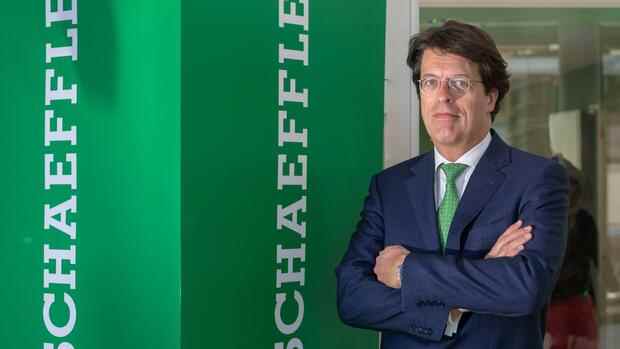The Schaeffler boss sees a long-term investment in the joint venture with Michelin and Faurecia.
(Photo: imago images/argum)
Paris, Dusseldorf Schaeffler is increasing its commitment in the field of hydrogen drives. The German company cooperates with Symbio, a joint venture between the French suppliers Faurecia and Michelin. On Tuesday, the companies in Paris announced the founding of the “Innoplate” joint venture.
The joint venture will be based in Haguenau, France. By 2030, more than 120 employees will be working there on fuel cell drives. The start of production is planned for 2024.
Symbio brings the system expertise for the production of the fuel cell to the joint venture, while Schaeffler supplies the metal bipolar plates required for this, as Schaeffler boss Klaus Rosenfeld says in an interview with the Handelsblatt. The bipolar plates are a core component of the fuel cell system. Among other things, they provide an electrical connection between the cells in the fuel cell system.
“The establishment of this Franco-German project will also strengthen the European value chain for mobility through hydrogen,” said Schaeffler and Symbio. Hydrogen is one of the European Union’s industrial priorities. Joint investments are intended to generate more green hydrogen and build the associated infrastructure. This green hydrogen could be used both in industry and in mobility. The deal between the auto suppliers also has a political dimension.
Top jobs of the day
Find the best jobs now and
be notified by email.
Germany and France in particular are exploring the possibilities for closer cooperation on hydrogen. At the beginning of 2021, the French gas specialist Air Liquide and the German energy technology group Siemens Energy announced a partnership in the green hydrogen business. The companies are jointly developing electrolysers for the production of hydrogen. France’s Economics Minister Bruno Le Maire demands that Paris and Berlin “set common goals for future technologies in the energy sector, such as hydrogen”.
Hydrogen drives have hardly played a role so far
According to Rosenfeld, at the first joint location in Haguenau, significant investments are necessary at the beginning to set up the production technology. All partners initially invest 100 million euros in the joint venture. By 2030, the joint venture between Schaeffler, Faurecia and Michelin wants to produce around 50 million biopolar plates annually. At the start of production there should be around four million. According to Symbio CEO Philippe Rosier, around 15,000 hydrogen vehicles could be equipped with this – an ambitious plan given the current number of hydrogen car registrations.
According to data from market observer Jato Dynamics, just 15,500 hydrogen-powered cars were sold worldwide last year. The vehicles are produced almost exclusively by the Japanese manufacturers Toyota and Hyundai. Other large car manufacturers such as Volkswagen or Mercedes, on the other hand, are focusing on battery-electric mobility.
In the passenger car sector, hydrogen propulsion is still a niche technology.
(Photo: dpa)
According to Symbio, the joint venture already has a customer in the automotive sector. The description could fit the Opel mother Stellantis, which has already worked with Symbio in the hydrogen sector.
At the end of April, Stellantis announced two high-ranking personalities: Jean-Michel Billig, previously with the shipbuilder Naval Group, is to start at the end of June as Chief Technology Officer for the development of vehicles with hydrogen fuel cells at the international car company. In addition, Opel boss Uwe Hochschurtz will take on the “worldwide control of the commercialization of hydrogen fuel cell vehicles” as an additional task.
The low number of registrations for vehicles with hydrogen drives nevertheless raises the question of how sustainable the joint venture is in the end. “We see the hydrogen joint venture as a long-term investment in the future,” says Rosenfeld. The first customer of the joint venture does not only have the passenger car sector in mind. The commercial vehicle market should also be supplied. The Schaeffler boss is therefore confident: “If the ramp-up is successful, then it will definitely not be the last plant of this type that we will build,” he says.
More: With the takeover, Schaeffler is pushing into the growing robotics industry
